Weather as entertainment

You don't need a weatherman
To know which way the wind blows
"Subterranean Homesick Blues" — Bob Dylan
WCVB-TV meteorologist Mike Wankum seemed crestfallen last Sunday night during a post-mortem of Winter Storm Jonas. A mere six inches of snow fell on Boston as a large swath of the country – 71 million Americans in 16 states, we were constantly reminded – were affected by this "epic storm" and "most impressive blizzard," which set numerous weather-related records.

